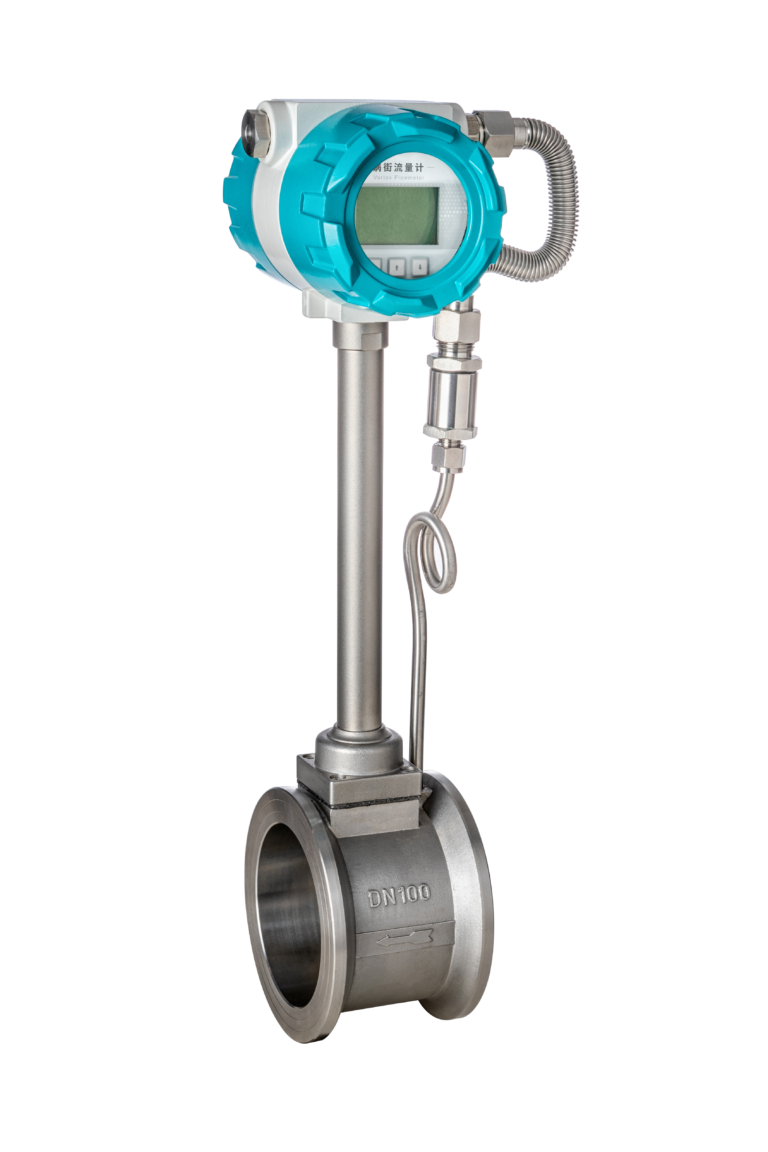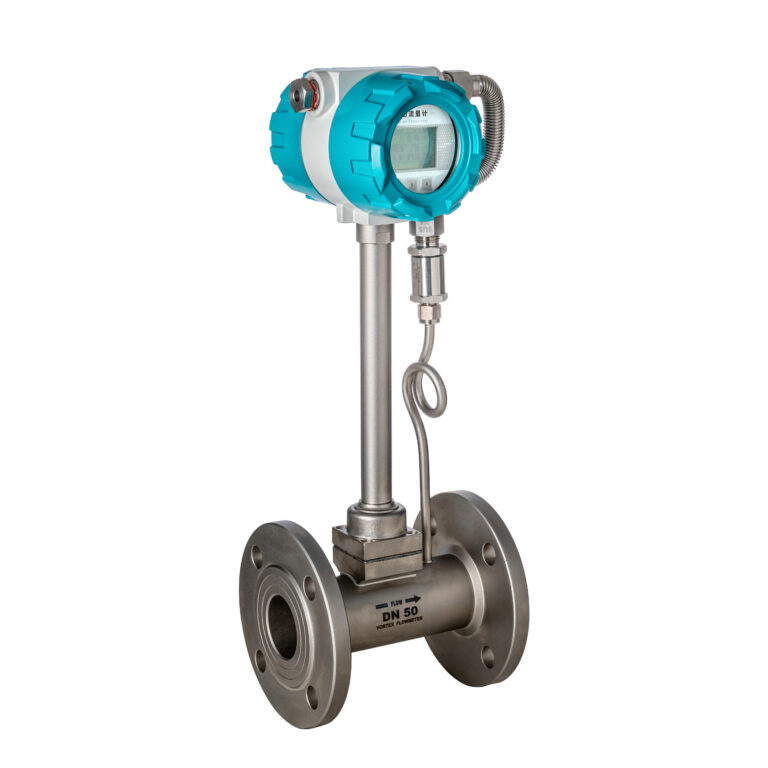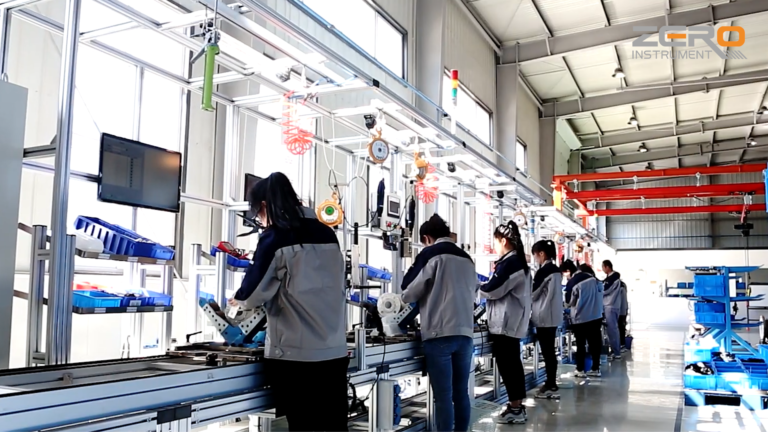1. Measured Medium
The vortex flow meter is generally suitable for measuring gases, liquids, and steam, but it is not appropriate for the following types of media:
- Fluids containing a large amount of solid particles or suspended matter.
- Media with excessively high kinematic viscosity under operating conditions, such as some high-viscosity oils (e.g., heavy oil).
Additionally, for the name of the measured medium, if the medium is steam, it is necessary to specify whether it is saturated steam or superheated steam.

2. Flow Range
The common flow rate should be controlled in the middle to upper range of the vortex flow meter’s measurable range: Since the measurement of the lower flow limit of a vortex flow meter is easily affected by pipeline vibrations, it is best to avoid measuring at the low end of the range.
If the flow range exceeds the measurable range of the vortex flow meter, the diameter can be reduced or expanded. However, attention should be paid to the following:
- The diameter reduction or expansion should not be too large, as reducing the diameter increases flow velocity, which adds resistance and back pressure, while expanding the diameter can easily cause cavitation.
- If the straight pipe section allows, a “reducer + straight pipe section” configuration should be selected to ensure stable fluid measurement.
- The choice of flow range should also consider whether the Reynolds number falls within the normal range.
The vortex flow meter is not suitable for measuring pulsating flow: Mechanical equipment such as Roots blowers or reciprocating pumps in the pipeline system can generate strong pulsations. If the pulsation frequency falls within the vortex shedding frequency range, it will cause measurement errors, and in severe cases, may prevent the formation of Kármán vortices altogether.
3. Pipeline Diameter
Vortex flow meters can be divided into inline and insertion types based on the installation method. For the inline type, the pipeline diameter is similar to most other flow meters, with the minimum size being DN15 and the maximum reaching DN300.
If a larger diameter is required, the insertion type can be selected, with the standard diameter range reaching up to DN2000. For diameters above DN2000, the supply is provided according to a specific agreement.

4. Measurement Accuracy
The accuracy of vortex flow meters comes in several levels, categorized by the type of measured medium. For inline vortex flow meters, the measurement accuracy can reach 1.0 for liquids and 1.5 for gases. For insertion-type vortex flow meters, the accuracy can reach 1.5 and 2.5 levels.
5. Medium Temperature
Generally, there are three temperature ranges: normal temperature, medium temperature, and high temperature. The temperature ranges are as follows: -40 to 100°C (normal temperature), 100 to 250°C (medium temperature), and 100 to 320°C (high temperature). If the medium temperature is higher, such as in the case of superheated steam, an orifice plate flow meter can be used for measurement.
6. Nominal Pressure
The nominal pressure is mainly categorized by the installation method. The primary market demands are as follows:
- Wafer-type flanged (2.5 MPa)
- Flanged connection type (1.0/1.6/2.5 MPa)
- Insertion-type installation (1.6 MPa/2.5 MPa/4.0 MPa).
7. Power Supply
According to current market demands, the main power supply options include +12VDC (three-wire pulse output), +24VDC (three-wire pulse output and two-wire current output), 3.6V lithium battery, and dual power supply.
8. Output Signal
According to current market demands, the main output signals include voltage frequency pulse output, two-wire 4-20mA output, and HART output. Additionally, in some cases, digital output may be required, and we can also provide Modbus RS485 communication.

9. Installation Environment
Choose the vortex signal output method based on the purpose of the vortex flow meter, with the main options as follows:
When the measured medium is a compressible fluid and there are significant changes in the medium’s temperature and pressure, it is recommended to use a vortex sensor with remote pulse signal transmission, paired with a flow totalizer with temperature and pressure compensation, a pressure transmitter, and a temperature transmitter.
If the flow meter is installed indoors in a good environment where remote signal transmission is unnecessary and the flow value can be easily read onsite, a digital vortex flow meter is recommended.
In cases where the installation environment is poor, the flow meter’s location is inconvenient for onsite reading, or centralized management is required, it is recommended to use a sensor with pulse signal output and a flow totalizer, or a vortex transmitter with 4-20mA standard current output.
When both onsite flow observation and remote signal transmission are needed, a digital vortex transmitter with 4-20mA output is recommended.
When there is no need for onsite reading and only remote transmission of a standard signal is required, a vortex transmitter with 4-20mA standard current output is recommended.
10. Protection Rating
The commonly used IP protection levels for vortex flow meters are IP65, IP67, and IP68:
- IP65 represents protection against dust intrusion and protection from water jets.
- IP67 represents protection against dust intrusion and temporary submersion.
- IP68 represents protection against dust intrusion and continuous submersion.
In general, the appropriate IP protection level should be selected based on the installation location of the vortex flow meter:
- For indoor installations, IP65 is sufficient.
- For outdoor installations above ground, select a protection level of IP65 or higher.
- For outdoor installations below ground, such as in trenches, select IP68 along with a separated amplifier to prevent damage from water immersion after rainfall.
In flammable and explosive environments, explosion-proof vortex flow meters should be selected.

Regarding Temperature and Pressure Compensation
Vortex flow meters can be equipped with temperature and pressure compensation to enhance measurement accuracy, especially when dealing with compressible fluids like gases and steam. Temperature and pressure fluctuations significantly affect the volume and flow rate of such fluids, which can lead to inaccuracies if not compensated for.
Temperature and pressure compensation works by measuring the actual temperature and pressure of the medium in real time, and then calculating the corrected flow based on these values. This is particularly important in the following scenarios:
- Steam Measurement: For steam, especially superheated steam, the volume changes significantly with temperature and pressure. Without compensation, the flow reading can deviate greatly from the actual value.
- Gas Measurement: When measuring gases, compensation adjusts for changes in gas density caused by fluctuations in temperature and pressure, ensuring more accurate readings.
- High-Pressure Systems: In high-pressure applications, pressure compensation is necessary to account for the effects of pressure on flow rate and medium properties.
Using a flow totalizer with temperature and pressure compensation, along with appropriate pressure and temperature transmitters, ensures accurate measurement under varying conditions.
